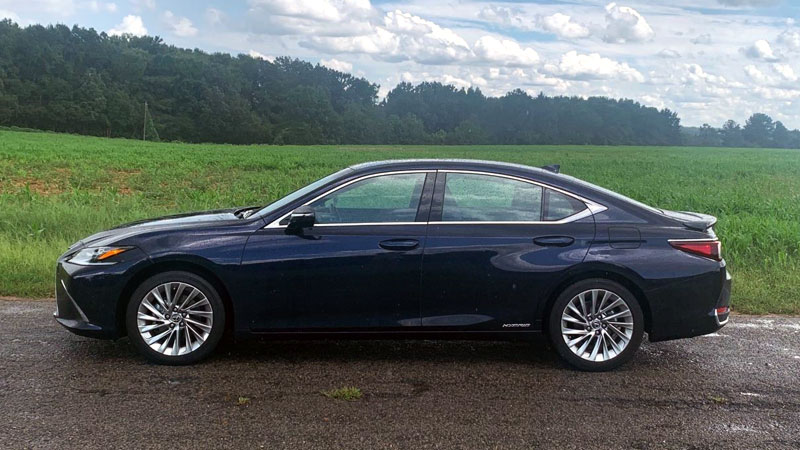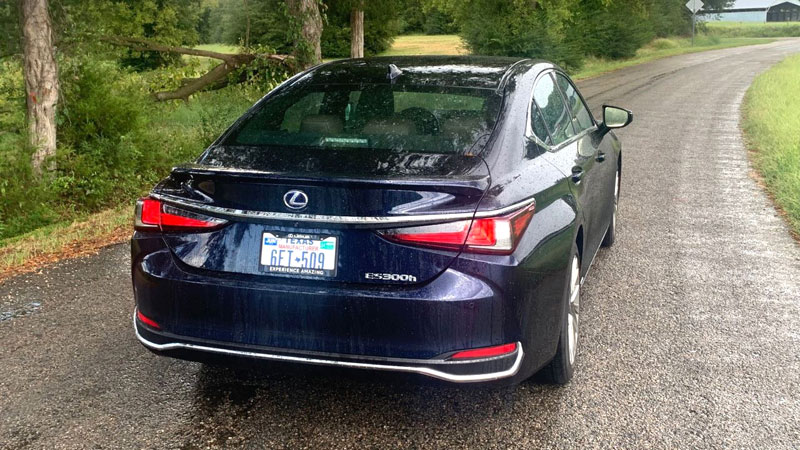Table of Contents
Luxury and value seldom intersect, but there are a few exceptions. The Lexus ES 300h is an exception as this large front-wheel-drive sedan can be had for under $50,000.
Moreover, it comes well equipped and offers a hybrid variant, the latter our recent weekly test driver.
2023 Lexus ES Review
Formally known as the Lexus ES 300h, the 2023 ES Hybrid comes in five grades: 300h ($43,690), F Sport Design ($48,075), Luxury ($48,860), F Sport Handling ($49,985), and Ultra Luxury ($52,480). These prices include the delivery, processing, and handling fee.
If you’re looking at the gas models (ES 250 and ES 350), the prices range from $42,490 to $51,280 and span four grades. For this review, our focus is on the hybrid. That said, we’ll look at the gas model as warranted.
Exterior Remarks

Until the most recent generational change, the Lexus ES and Toyota Avalon were siblings. With the current ES, Toyota claims they are different. In any case, the two models are similar in size. Unfortunately, 2022 was the final year for the Avalon while the ES soldiers on. At least for now.
Like every Lexus model, the ES is dominated by an hourglass (spindle) grille. It offers a love-it or hate-it proposition, a polarizing design that’s for certain.
A glimpse at the overhauled 2023 RX crossover, though, shows that future Lexus models will still offer the design, but the look is comparatively restrained. We only wish BMW would take a cue from Lexus and tone down its frontal drama.
As for the ES, it offers an elegant presentation with LED lights, beautiful signature lines, modest sculpting, and a sweeping roofline. It doesn’t pretend to have the accompanying sporty credentials (the IS sedan does that), but it does draw attention.
Among the standard features are 17-inch alloy wheels, heated side mirrors, and a power moonroof. Available 18-inch wheels appear in the Luxury grade. As for F Sport models, these come with 19-inch alloy wheels, suspension tuning, and a rear spoiler.
Interior Highlights

Arguably, Lexus sets the bar amongst luxury brands for quality of materials as well as fit and finish. The ES Hybrid’s cabin is quiet, comfortable, and spacious.
Indeed, this is where the front-wheel-drive platform pays off for the ES. Behind the plush and supportive front-row chairs is an equally comfortable rear bench seat. That seat is wide, able to comfortably fit three adults, and offers ample legroom that leads the segment.

Even with the sloping roofline, the seatbacks are angled perfectly to supply sufficient headroom. A whopping 16.7 cubic feet of trunk space should clinch it for some shoppers.
Imitation leather seating and a 10-way power driver’s seat come standard. Moving up through the grades brings in full leather seats, heated and ventilated front seats, and a power rear sunshade. You’d be hard-pressed to find plastic surfaces in the ES.
Some grades add wood trim pieces and even a wood steering wheel that is partially wrapped in leather. It supplies a heating function, and power tilts and telescopes. Manual rear side window sunshades and an F Sport steering wheel are other accessible features of note.
Tech Equipment

Even as many models offer large center console screens, an 8-inch touch-screen unit is standard with the ES. The screen’s size and its usability trail the competition.
You can upgrade to a 12.3-inch screen across the model range. This improvement is part of a technology package that includes navigation for $1,030.
The remainder of the ES’ tech features includes Android Auto, Apple CarPlay, and Alexa integration. A 10-speaker Pioneer audio system with HD Radio and satellite radio is standard or an available 17-speaker Mark Levison audio system can be selected.
Bluetooth, a Wi-Fi hotspot, and multiple USB ports come standard. Move up through the grade range and a wireless charging pad appears.
Safety Features
Lexus bundles numerous driver-assist tech features under its Lexus Safety System 2.5 suite. This means every model has a pre-collision system with pedestrian detection. This feature also includes daytime bicyclist detection and left turn intersection support.
Other features include road sign assist, automatic high beams, and lane departure alert with steering assist. Lane tracing assist is another feature of note. As the name suggests, the system keeps the Lexus perfectly centered in its lane. Rounding out the bundle is adaptive cruise control with full stop and go.
Included separately, but still supplied as standard equipment is blind-spot monitoring with rear cross-traffic alert. A 10-inch head-up display comes with the Ultra Luxury grade.
Powertrain Choices
Which Lexus ES is right for you? Both have distinct advantages. The gas model offers a 3.5-liter V6 engine with 302 horsepower and 267 pound-feet of torque. Power routes to the front wheels with an 8-speed automatic transmission. It delivers a respectable 22/32/26 mpg city/highway combined.
Also available is all-wheel drive. But to get this feature means choosing the available 2.5-liter four-cylinder engine. This model makes 203 horsepower and 184 pound-feet of torque and utilizes an 8-speed automatic transmission.
The decreased power and added weight of all-wheel drive may not justify the tradeoff. This model makes 25/34/28 mpg city/highway/combined.
The middle ground is occupied by the hybrid. It, too, utilizes a 2.5-liter naturally aspirated four-cylinder engine. This version is engineered for efficiency and delivers just 176 horsepower and 163 pound-feet of torque. But under full throttle, the engine and front electric motors combine for 215 horsepower.
Importantly, this model is the efficiency king as it makes 43/44/44 mpg city/highway/combined. Those are real-world numbers too as verified on our end. The ES Hybrid comes with front-wheel drive and utilizes an electronic continuously variable transmission.
Driving Highlights

The ES Hybrid won’t move the excitement needle for drivers. It doesn’t have to. Instead, it fulfills its mission splendidly, by sipping gas. The four-cylinder engine alone is efficient, but the Toyota Synergy Hybrid System is in a class of its own.
The electric motors dominate at certain times, allowing the engine to rest. But anytime additional power is needed, the gas engine kicks in. When the two systems are working in tandem, the power quotient rises to a decent level.
Although providing nowhere near the kick of the V6, the hybrid never lags. Is there a downside? Yes, the continuously variable transmission forces the engine to rev higher than it should when passing.
Lexus supplies all ES models with weighted steering and fair handling. It operates best on the open road, while twisty roads reveal an increased level of body roll. The base gas engine with all-wheel drive offers the best handling but supplies the least amount of power.
Choose the hybrid’s F Sport trims or the Ultra Luxury grade and performance dampers are added for improved ride comfort and better body control.
Lexus ES Considerations
Lexus remains committed to sedans, at least for now. The IS supplies a performance edge, the ES touts affordable luxury, while the LS dukes it out with the BMW 7 Series and Mercedes-Benz S-Class in all matters of opulence.
We believe the ES Hybrid is a solid choice and a compelling alternative to the V6 model. So long as fuel prices remain elevated, it is a sensible choice too, one that pays off within a few years while supplying lifelong efficiency.
Photos copyright Auto Trends Magazine. All rights reserved.

